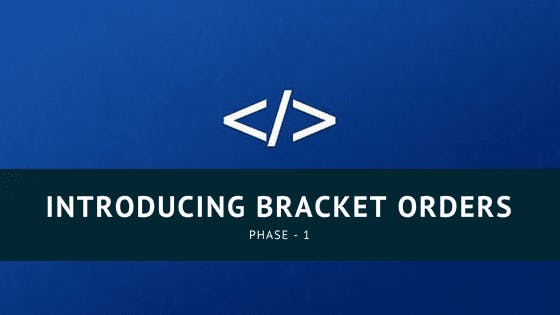
I am happy to announce that we have introduced Bracket Orders on our trading platforms. After receiving a ton of feedback from our active trading clients, we have decided to introduce bracket orders in 2 phases. This is to ensure a glitch-free implementation of bracket orders and that the execution complexities of the Bracket order mechanism can be dealt with in a systematic manner.
In phase one, the tool will be activated for the equity segment alone which could be for a week and in the following phase, it will be allowed in all the segments including F&Os and Currency Derivatives. In this post, you will understand how to use our various trading platforms to place a Bracket Order. But before that let’s first understand how a Bracket Order functions.
What is a Bracket Order?
It is an OCO (One Cancels Other) order with which you can take a fresh position (either long or short) with a compulsory “stop-loss” and a “target/book-profit” order. Therefore, when the main order is placed (buy or sell) the other two orders (stop-loss and target) will be placed simultaneously.

So technically, when either a stop-loss or a target price is executed, the other leg of the bracket order gets cancelled automatically. Let’s now look at some of its features:
1. Compulsory stop-loss and target price:
As mentioned above, while placing a bracket order you need to ensure that depending upon the position a valid stop-loss price and a target/book-profit price is mentioned in the order entry window.
2. Trailing stop-loss:
In the bracket order, you get an option to activate the trailing stop-loss while placing an order. The trailing stop-loss function helps to keep your stop-loss price moving up/down if the stock price/position moves in the profitable direction. This component is currently disabled and will be introduced in Phase - 2.
3. Higher leverage/margin:
You can avail a much higher leverage/margin through Bracket Orders. Similar to cover orders, bracket orders have a mandatory stop-loss order which reduces the risk of losing money beyond a point. We’re presently providing 30 times margin for the equity intraday segment and up to 67 times margin for the F&Os intraday segment under the bracket and cover orders. For more details on the leverage available on bracket orders, you can refer to our Margin Calculator.
4. Can be placed as Limit Order:
Bracket Orders can be placed using only the “Limit Order” product type. It cannot be placed using other types such as Market Order, Stop-loss Limit Order etc. as of now. However, if you wish to place a Buy or Sell order at the market price, then all you need to do is place an order with the limit price above the market for a long position and a limit price below the current market price for a short position. This is to ensure safe risk management practices.
5. Auto square off:
Bracket orders are basically intraday orders. If a bracket order trade is not squared off by clients before our auto-square off time, it will get automatically squared off at around before the market closes for the day as per our risk management policies.
How to place a Bracket Order?
You can place bracket orders using either of our three trading platforms:
- Fyers Web
- Fyers One
- Fyers Markets
We have kept the user interface very intuitive to make the order placement hassle-free. Now let’s discuss how to place a bracket order for each trading platform separately.
1. Order placement on Fyers Web:
To place bracket orders on Fyers Web you can choose a scrip on the Watchlist and open the new order entry window. You can use the shortcut keys such as SHIFT+B for Buy order and SHIFT+S for Sell order to access the order entry window instantly. Well, to open the order entry window on Fyers Web there are multiple ways which will be explained in a detailed video tutorial. I will post the link here soon.
I would also like to mention that after taking a constant feedback from our users we have modified the complete user interface of the order entry window on Fyers Web. You can refer to the image below.

2. Order placement on Fyers One:
To place bracket orders on Fyers One, you can select a script and click F1 for Buy order and F2 for Sell order. You can refer this post to learn order placement on Fyers One. Once the order window pops up on the screen you can refer the image below to understand the functionality.

3. Order placement on Fyers Markets:
In one of our previous blogs on the Cover Order placement, I did mention how to reach to the order entry window on Fyers Markets. Once you reach to the order entry window then you simply need to select the “BO” option from the product type to place a bracket order. You can refer to the image shown below for more clarity,

Once you fill up all the details in the order entry form, you can click “Submit” to place the order.
Now let’s discuss the modification and exit methods of the Bracket Order:
1. Modifying a bracket order:
When it comes to the modification of a bracket order it is slightly different from that of a cover order. This is because a bracket order is more complex as compared to a cover order. We know that there are three positions involved in a bracket order namely,
a. Primary/main order (Leg -1)
b. Stop-loss order (Leg -2)
c. Target/book-profit order (Leg-3)
The main order (Leg -1) is entered when you take a new position either buy or sell using the bracket order product type. As mentioned earlier, this is always entered as a “Limit Order” into the system. Therefore, this order can be modified as long as it gets executed.
On the other hand, the stop-loss (Leg -2) and the target (Leg -3) orders are subject to modification depending upon the status of the main order. What this means is that if the main order is still pending, you cannot modify the stop-loss and the target orders since the Leg -2 & Leg -3 are still not sent to the exchange’s server by the system. However, the stop-loss and target orders can be modified only when the main order gets executed this is because once the primary order gets traded the other two orders (Leg -2 & Leg -3) are sent to the exchange’s server as pending orders.
I have shown this in a simple diagram to make it simple to understand.

2. Exiting a bracket order:
Usually, a bracket order is exited by hitting either a target or a stop-loss order. Needless to say, once either of the orders is executed the other one gets cancelled automatically. However, if a trader wants to manually exit/cancel a bracket order, he can either cancel the target or the stop-loss order from the “Order Book” and the position gets executed at the existing market price.
Considering that the successful implementation of bracket orders has been a challenge for other platforms, we have launched it in the equity intraday segment to begin with. Soon, we will enable it in all the segments and post that we will work on launching Phase 2 of bracket orders. I hope this explanation was helpful. Stay tuned for more updates and happy trading!


